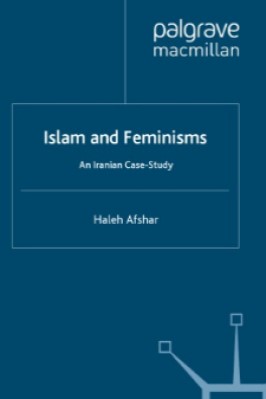Islam and Feminisms: An Iranian Case-Study

| Islam And Feminisms |
| Haleh Afshar |
| 250 |
| |
| PDF Direct Download Link |
| Click for Hard Copy from Amazon |
ISLAM AND FEMINISMS – Book Sample
Islamist Women in Iran
The widespread support given by Iranian women to Islam, and its revolutionary ardour in the 1970s, heralded what has become known as ‘feminist fundamentalism’ (Hoffman 1985; Ahmed 1992; Afshar 1994, 1996).
it is the culmination of over a century-long critical engagement by Islamist women with Western liberal and Marxist feminist perspectives. Islamist women daim to have carved their own patlı to liberation (Rahnavard n.d.; Rezayi 1979; Mernissi 1995).
They argue that by returning to the sources of Islam, they are able to reinterpret the text of the Koran and the practices of the faith, sunna, to create a preferable, alternative, ‘correct’ patlı for women at the end of the twentieth century (Zin al-Din 1928; Ahmed 1992; Bouthanian 1995; Hoffman 1995).
They advocate gender complement arity rather than equality as a means of serving their faith and living fulfilling lives. They note that Islam demands respect for women and accommodates their different life-choices. it offers them the opportunity to be scholarly, educated and gainfully employed, while at the same time provides an honoured space for those who choose to become mothers, wives and home-makers.
lslamist women argue that, unlike Marxism, capitalism and much of feminist discourse, Islam recognises the importance of women’s life-cycles; they have been given different roles and responsibilities at different times of their lives and at each and every stage they are valued and respected for what they do.
Islam at its inception provided them with exemplary role-models and has delineated a patlı that can be followed honour ably by ali. in Iran they have claimed that Islam can be a liberating force.
However, in practice, the process of Islamist liberation has been far from easy for Iranian women. This is because of the political marginalisation of women in the early post-revolutionary days and the supremacy granted by the lslamic Republic’s Constitution to men, in both their personal and public lives (Omid 1994).
The preamble to the Constitution states clearly that men and women are not equal. Women are said to have been ‘freed’ of the objectification imposed on them by the West, given the ‘critical duty’ of motherhood, and placed firmly in the home. They are to guard the family, which was declared to be the fundamental basis of the Islamic Republic (Article 10).
in March 1979, a month after his return to Iran, Khomeini sacked all female judges and ordered the compulsory veiling of women. in May of the same year co-education was banned. in June married girls were barred from attending school, and the government began closing down workplace nurseries. in July seaside resorts were sexually segregated and women flogged in public for moral and dress code transgressions.
For the first time in twentieth-century Iranian history women were executed for prostitution and moral degradation. By October the government was dismantling the checks placed on men by over 50 years of struggles to revise the personal laws; men thereby regained the unreciprocated right to polygamy, to unilateral divorce on demand, and to prevent their wives from undertaking paid employment.
The official age of marriage for women was reduced from 18 to 13 and men regained automatic custody of their children after divorce.
THE RECONSTRUCTION OF POST-REVOLUTIONARY ISLAMISM
Despite the radical losses in law and civil liberties, continuous strug gles by elite Iranian women have stemmed the tide of the legal erosions and have overturned some of the more Draconian measures. Since they have become the public face of the state (Chhachhi 1991; Afshar 1982, 1992) and the standard-bearers of public morality, women are in a relatively strong position to demand commensurate rewards.
The government in Iran presents its approach to women as a template for other Islamic nations to follow. it argues that Islam has granted women a high status, that their independent Islamic eco nomic and social rights are enshrined in the holy text of the Koran, and are therefore permanent.
Although the Islamic government pro jects its position on women’s rights as that of the universalist, eternal Islam and its people, umma (Mottahari 1980), in reality, these rights are subject to a post-Islamic reconstruction, which is stili undergoing intense negotiations (Kandiyoti 1988) between Islamist Iranian elite women (Moghissi 1996) and their government.
The divitle is almost, though not entirely, along the traditional nature/nurture lines. The old-established religious leaders, ulama, and jurisconsults, foqha, from Ayatollahs Khomeini and Mottahari to Hojatoleslam Khamenieyi have, almost universally, opted for disempowering interpretations centred on the ‘natural sensitivity and
To read more about the Islam And Feminisms book Click the download button below to get it for free
Report broken link
Support this Website
for websites